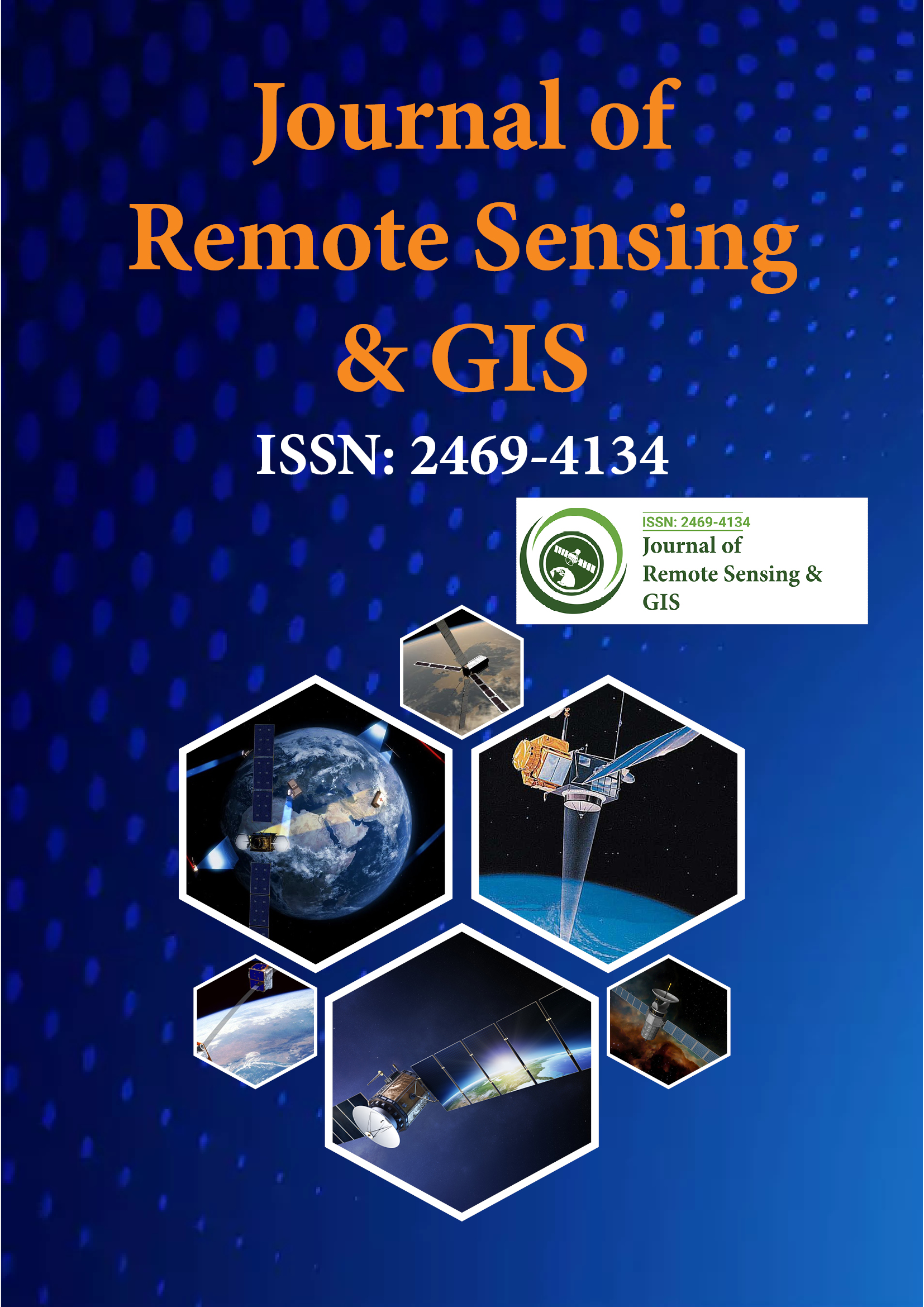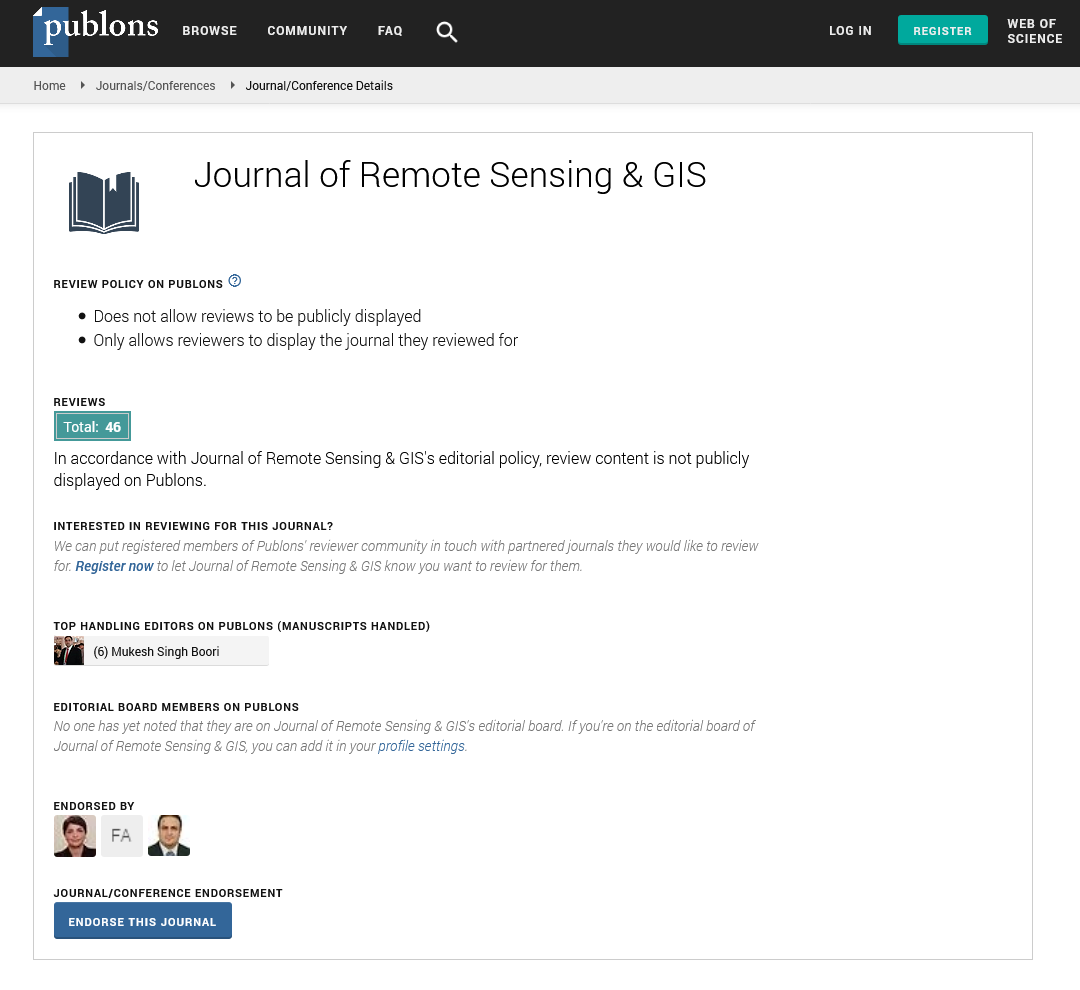Indexed In
- Open J Gate
- RefSeek
- Hamdard University
- EBSCO A-Z
- OCLC- WorldCat
- Publons
- International Scientific Indexing
- Euro Pub
- Google Scholar
Useful Links
Share This Page
Journal Flyer

Open Access Journals
- Agri and Aquaculture
- Biochemistry
- Bioinformatics & Systems Biology
- Business & Management
- Chemistry
- Clinical Sciences
- Engineering
- Food & Nutrition
- General Science
- Genetics & Molecular Biology
- Immunology & Microbiology
- Medical Sciences
- Neuroscience & Psychology
- Nursing & Health Care
- Pharmaceutical Sciences
Commentary Article - (2024) Volume 13, Issue 1
Exploring Earth's Geodynamic Processes through Remote Sensing Technologies
Sabah Barber*Received: 01-Mar-2024, Manuscript No. JGRS-24-24596; Editor assigned: 04-Mar-2024, Pre QC No. JGRS-24-24596 (PQ); Reviewed: 18-Mar-2024, QC No. JGRS-24-24596; Revised: 25-Mar-2024, Manuscript No. JGRS-24-24596 (R); Published: 01-Apr-2024, DOI: 10.35248/2469-4134.24.13.333
Description
The Earth, a dynamic and ever-evolving planetary system, operates as a complex engine of geological processes that shape its surface and drive its movements. Geodynamics, the scientific study of these dynamic processes, offers a glimpse into the inner workings of our planet. In recent years, the integration of geodynamics with remote sensing technologies has opened up new frontiers, allowing scientists to observe and analyze Earth's engine in action from a perspective never before possible. The utilization of remote sensing tools to capture and interpret data relevant to geodynamic processes. Satellites equipped with an array of sensors act as Earth's sentinels, continuously monitoring and collecting data that provide into the forces shaping the planet's surface. Tectonic plate movements, a fundamental aspect of geodynamics, are observable through remote sensing technologies. Satellites equipped with Synthetic Aperture Radar (SAR) and Global Positioning Systems (GPS) provide unparalleled precision in measuring ground deformation along fault lines and plate boundaries. This capability allows scientists to monitor tectonic plate movements, detect potential earthquake zones, and understand the subtle shifts that precede seismic events. The marriage of geodynamics and remote sensing is particularly evident in the study of subduction zones, where one tectonic plate is forced beneath another. Through satellitebased observations, scientists can track the subduction process by monitoring changes in the Earth's surface. This not only enhances our understanding of subduction dynamics but also contributes to the assessment of associated hazards such as tsunamis and volcanic activity.
Volcanic eruptions, a dynamic manifestation of geodynamics, are another focal point of remote sensing applications. Satellites equipped with thermal infrared sensors and multispectral imaging capabilities capture the thermal signatures and visual cues associated with volcanic activity. Monitoring changes in surface temperature and identifying alterations in the landscape aid in predicting eruptions and assessing potential risks to surrounding regions. The integration of satellite data with geodynamic models provides a comprehensive understanding of volcanic behavior. Scientists can analyze deformation patterns, gas emissions, and thermal abnormalities, contributing to early warning systems and emergency response planning. Remote sensing thus becomes a tool in mitigating the impact of volcanic events on human populations. Earthquakes, as seismic expressions of geodynamic energy release, also fall within the purview of remote sensing. Interferometric Synthetic Aperture Radar (InSAR) technology, a sophisticated remote sensing technique, allows scientists to measure ground deformation caused by seismic events with remarkable precision. By comparing radar images acquired before and after an earthquake, researchers can create detailed displacement maps, helping to identify fault lines and assess the extent of ground movement.
Beyond immediate geodynamic events, remote sensing aids in monitoring long-term processes such as crustal deformation and continental drift. Instruments onboard satellites, including those sensitive to gravitational variations, provide valuable data for understanding the slow but continuous movements of the Earth's lithosphere. This data contributes to the refinement of geological models and aids in reconstructing the Earth's geological history. The application of remote sensing to geodynamics is not limited to the solid Earth it extends to the study of the Earth's hydrosphere and atmosphere. Satellite observations contribute to understanding ocean dynamics, including currents, sea level changes, and the interactions between the oceans and the solid Earth. Additionally, remote sensing plays a role in studying atmospheric phenomena such as pressure systems, wind patterns, and the dynamics of weather-related events, all of which are interconnected components of the Earth's engine.
Furthermore, the integration of geodynamics and remote sensing proves invaluable in addressing environmental challenges related to anthropogenic activities. Land subsidence caused by factors such as groundwater extraction and urbanization can be monitored and analyzed through satellite imagery. Remote sensing data offer critical insights into the impact of human activities on the Earth's surface and contribute to sustainable resource management. Despite the transformative potential of remote sensing in geodynamics, challenges persist.
Ensuring the continuity of satellite missions, addressing data resolution limitations, and refining data processing techniques are ongoing endeavors. Additionally, the collaborative efforts of geoscientists, remote sensing experts, and data analysts are essential for extracting meaningful information from the vast datasets generated by satellites. Remote sensing the Earth's engine has become contemporary geodynamics. Satellites equipped with advanced sensors provide a panoramic view of the dynamic processes shaping the planet's surface and subsurface. From tectonic plate movements to volcanic eruptions and seismic events, remote sensing serves as an invaluable tool for monitoring, understanding, and ultimately mitigating the impact of geodynamic processes on our planet. As technology advances and satellite capabilities evolve, the collaboration between geodynamics and remote sensing promises to unveil even deeper insights into the workings of Earth's intricate engine.
Citation: Barber S (2024) Exploring Earth's Geodynamic Processes through Remote Sensing Technologies. J Remote Sens GIS. 13:333.
Copyright: © 2024 Barber S. This is an open-access article distributed under the terms of the Creative Commons Attribution License, which permits unrestricted use, distribution, and reproduction in any medium, provided the original author and source are credited.

